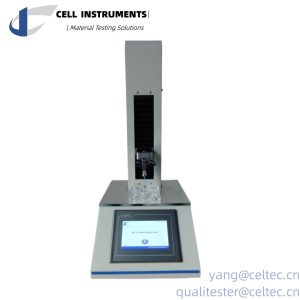Penetrability Test for Rubber Stoppers
Importance of Penetrability Test for Rubber Stoppers
Penetrability testing assesses the force required by medical needles, such as those used in syringes, to pierce the rubber stoppers of vials.
Quality Control
This test is crucial for ensuring that rubber stoppers effectively seal medication containers, preventing contamination, leakage, and potential harm to patients. By accurately measuring the penetrability of rubber stoppers, manufacturers can uphold the highest standards of product integrity and patient safety, ultimately contributing to the reliability and efficacy of pharmaceutical products.
Development of Medical Needle
In the R&D laboratory, penetrability testing provides critical insights into the performance and durability of different needle designs. By measuring the force required to penetrate rubber stoppers of varying compositions and thicknesses, manufacturers can optimize needle design parameters such as gauge, tip geometry, and surface finish. These optimizations aim to enhance the ease of penetration, minimize the risk of needle breakage or deformation, and improve overall user experience for healthcare professionals and patients.
Development of Vial Rubber Stopper
Similarly, penetrability testing plays a pivotal role in the advancement of rubber stopper technology. Through systematic testing, manufacturers can evaluate the impact of material formulations, processing techniques, and structural features on stopper penetrability. This data informs the development of rubber stoppers that strike the optimal balance between seal integrity and ease of needle penetration. By iteratively refining stopper designs based on penetrability test results, manufacturers can deliver products that meet stringent performance requirements while ensuring compatibility with a wide range of medical devices and drug formulations.
Process – Penetrability Test for Rubber Stopper
The penetrability test involves securing the rubber stopper in place and puncturing it with a needle at a constant rate. The force required to penetrate the stopper is measured and compared against established criteria.
- The rubber stopper is securely placed in the testing apparatus.
- A standard medical needle, such as one used in syringes, is aligned with the stopper.
- A controlled force is applied gradually to the needle, simulating the process of piercing the stopper.
- The force required for the needle to penetrate the stopper is measured and recorded.
This process assesses factors such as puncture resistance, self-sealing ability, and overall performance under stress.
Penetrability Test for Rubber Stoppers Relevant Standards
Several standards govern penetrability testing for pharmaceutical rubber stoppers, ensuring consistency and reliability across the industry. Commonly referenced standards include ISO 7886, and USP <381>. These standards outline test methods, equipment requirements, and acceptance criteria for evaluating stopper penetrability.
Penetrability Test for Rubber Stoppers Solution- Medical Needle Puncture Tester
Cell Instruments offers the NPT-01 Medical Needle Puncture Tester, a state-of-the-art instrument designed specifically for penetrability testing of pharmaceutical rubber stoppers. This automated tester provides precise control over test parameters, ensuring accurate and repeatable results. With its user-friendly interface and customizable features, the NPT-01 streamlines the testing process while maintaining high levels of accuracy and reliability.
FAQs
1. What are the key factors affecting the penetrability of rubber stoppers?
The material composition of the stopper, its thickness, and the design of the needle used for testing are key factors influencing penetrability.
2. How does penetrability testing contribute to pharmaceutical safety?
Penetrability testing helps ensure that rubber stoppers effectively seal medication containers, preventing contamination, leakage, and potential adverse effects on patient health.
3. Can penetrability testing be customized to meet specific industry requirements?
Yes, the NPT-01 Medical Needle Puncture Tester offers customizable features to accommodate various testing needs, making it suitable for a wide range of applications in the pharmaceutical industry.
4. What issues should be paid attention to in penetrability testing?
The sample rubber stoppers are selected from the production batch, ensuring representative samples are chosen for testing. These stoppers may be sourced from different stages of production to account for variability.
5. How does the NPT-01 Medical Needle Puncture Tester differ from traditional testing methods?
The NPT-01 offers advanced automation, precision control, and user-friendly operation, significantly improving efficiency and accuracy compared to traditional manual testing methods.

